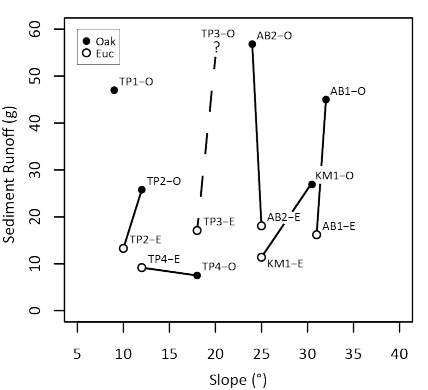Surface runoff and soil erosion under eucalyptus and oak canopy

Thompson A, Davis J, Oliphant A (2016). Surface Runoff and Soil Erosion under Eucalyptus and Oak Canopy. Earth Surface Processes & Landforms. http://dx.doi.org/10.1002/esp.3881 .
To assess potential differences in stormwater runoff and sediment yield between plots of blue gum eucalyptus (Eucalyptus globulus) and coast live oak (Quercus agrifolia), we measured runoff, sediment yield, water repellency and soil moisture at eight paired sites. Eucalyptus has been associated in many studies worldwide with elevated soil water repellency and increased runoff, a likely contributor to soil erosion. To better understand these connections and their relationship to land cover, there is a need for studies employing either rainfall simulators or natural rainfall. Our research employs the latter, and was subject to contrasting hydrologic conditions in the two years of the study. Field work was conducted from October 2006 to February 2008 in the San Francisco Bay Area of central California. During the 2006-07 winter wet season, runoff was significantly higher under eucalypts than at paired oak sites, and in the early phases of the season was connected with elevated water repellency. However, sediment yield at all sites during the 2006-07 hydrologic year was below the detection limit of the Gerlach sediment collection traps, possibly due to a limited wet season, and only appeared as suspended sediment captured in overflow buckets. Intensive rainfall events in January 2008 however created substantial runoff of sediment and litter with significantly greater yield at oak sites compared to paired eucalyptus sites. Water repellency likely had little effect on runoff during these events, and the primary cause of greater erosion under oaks is the thinner cover of leaf litter in comparison to eucalyptus. Our study is limited to undisturbed sites with intact litter cover that have not experienced recent wildfires; if disturbed, we would expect a different picture given the propensity for crown fires of eucalypts, enhancement of rainsplash erosion, and the likely greater potential for stream-connected sediment yield from post-disturbance soil erosion events.
Keywords:
- water repellency;
- eucalyptus;
- runoff;
- litter;
- sediment yield;
- soil moisture